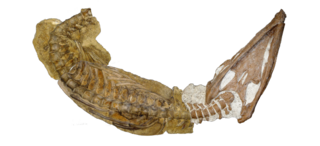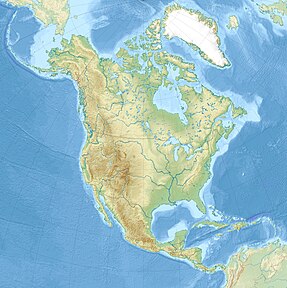
Kronosaurus is an extinct genus of short-necked pliosaurs that lived during the Early Cretaceous period in what is now Australia. It is a monotypic genus with one species K. queenslandicus, described in 1924 from the Toolebuc Formation in Queensland, Australia. With traditionally attributed fossils indicating a total length of up to 10 meters (33 ft), Kronosaurus may have been among the largest pliosaurs.

Pliosauroidea is an extinct clade of plesiosaurs, known from the earliest Jurassic to early Late Cretaceous. They are best known for the subclade Thalassophonea, which contained crocodile-like short-necked forms with large heads and massive toothed jaws, commonly known as pliosaurs. More primitive non-thalassophonean pliosauroids resembled plesiosaurs in possessing relatively long necks and smaller heads. They originally included only members of the family Pliosauridae, of the order Plesiosauria, but several other genera and families are now also included, the number and details of which vary according to the classification used.
Liopleurodon is an extinct genus of large, carnivorous marine reptile belonging to the Thalassophonea, a clade of short-necked pliosaurid plesiosaurs. Liopleurodon lived from the Callovian Stage of the Middle Jurassic to the Kimmeridgian stage of the Late Jurassic Period. It was the apex predator of the Middle to Late Jurassic seas that covered Europe. The largest species, L. ferox, is estimated to have grown to 6.4 metres (21 ft) in length based on a large skull.

Umoonasaurus is an extinct genus of plesiosaur belonging to the family Leptocleididae. This genus lived approximately 115 million years ago during the Early Cretaceous period, in shallow seas covering parts of what is now Australia. It was a relatively small animal around 2.5 metres (8.2 ft) long. An identifying trait of Umoonasaurus is three crest-ridges on its skull.

Plesiopleurodon is an extinct genus of Mesozoic marine reptiles, belonging to Sauropterygia, known from the Late Cretaceous of North America. It was named by Kenneth Carpenter based on a complete skull with a mandible, cervical vertebra, and a coracoid. In naming the specimen, Carpenter noted "Of all known pliosaurs, Plesiopleurodon wellesi most closely resembles Liopleurodon ferox from the Oxfordian of Europe, hence the generic reference." It was initially described as a pliosaur due to it short neck, a common trait of the family, although it is in the order Plesiosauria. However, later exploration into the relationships of both orders indicate that not all pliosaurs have short necks and not all plesiosaurs have long necks.

Dolichorhynchops is an extinct genus of polycotylid plesiosaur from the Late Cretaceous of North America, containing the species D. osborni and D. herschelensis, with two previous species having been assigned to new genera. Specimens of D. osborni have been found in the early Coniacian to early Campanian rocks, while those of D. herschelensis have been found in the late Campanian to early Maastrichtian rocks. Dolichorhynchops was a prehistoric marine reptile. Its Greek generic name means "long-nosed face". While typically measuring about 3 metres (9.8 ft) in length, the largest specimen of D. osborni is estimated to have a total body length more than approximately 4.3 metres (14 ft).

Brachauchenius is an extinct genus of pliosaurid that lived in North America and Morocco during the Late Cretaceous.

Leptocleidus is an extinct genus of plesiosaur, belonging to the family Leptocleididae. It was a small plesiosaur, measuring only up to 3 m (9.8 ft).

Simolestes is an extinct pliosaurid genus that lived in the Middle to Late Jurassic. The type specimen, BMNH R. 3319 is an almost complete but crushed skeleton diagnostic to Simolestes vorax, dating back to the Callovian of the Oxford Clay formation, England. The genus might also be known from the Tithonian Bhuj Formation of India (S.indicus), however the referral of this species to Simolestes is dubious. S.keileni from France was moved to the new genus Lorrainosaurus in 2023.

Baptanodon is an ichthyosaur of the Late Jurassic period, named for its supposed lack of teeth. It had a graceful 3.5 m (11 ft) long dolphin-shaped body, and its jaws were well adapted for catching squid. Major fossil finds of this genus have been recorded in North America. The type species, Sauranodon natans, was originally included under Sauranodon in 1879, but this name was preoccupied.
Eromangasaurus is an extinct genus of elasmosaurid known from northern Queensland of Australia.

Tatenectes is a genus of cryptoclidid plesiosaur known from the Upper Jurassic of Wyoming. Its remains were recovered from the Redwater Shale Member of the Sundance Formation, and initially described as a new species of Cimoliosaurus by Wilbur Clinton Knight in 1900. It was reassigned to Tricleidus by Maurice G. Mehl in 1912 before being given its own genus by O'Keefe and Wahl in 2003. Tatenectes laramiensis is the type and only species of Tatenectes. While the original specimen was lost, subsequent discoveries have revealed that Tatenectes was a very unusual plesiosaur. Its torso had a flattened, boxy cross-section and its gastralia exhibit pachyostosis (thickening). The total length of Tatenectes has been estimated at 2–3 meters (6.6–9.8 ft).

Pachycostasaurus is an extinct Pliosauroid from the Oxford Clay formation of Peterborough, England.
The Sundance Formation is a western North American sequence of Middle Jurassic to Upper Jurassic age Dating from the Bathonian to the Oxfordian, around 168-157 Ma, It is up to 100 metres thick and consists of marine shale, sandy shale, sandstone, and limestone deposited in the Sundance Sea, an inland sea that covered large parts of western North America during the Middle and early Late Jurassic.

This timeline of plesiosaur research is a chronologically ordered list of important fossil discoveries, controversies of interpretation, taxonomic revisions, and cultural portrayals of plesiosaurs, an order of marine reptiles that flourished during the Mesozoic Era. The first scientifically documented plesiosaur fossils were discovered during the early 19th century by Mary Anning. Plesiosaurs were actually discovered and described before dinosaurs. They were also among the first animals to be featured in artistic reconstructions of the ancient world, and therefore among the earliest prehistoric creatures to attract the attention of the lay public. Plesiosaurs were originally thought to be a kind of primitive transitional form between marine life and terrestrial reptiles. However, now plesiosaurs are recognized as highly derived marine reptiles descended from terrestrial ancestors.

Megacephalosaurus is an extinct genus of short-necked pliosaur that inhabited the Western Interior Seaway of North America about 94 to 93 million years ago during the Turonian stage of the Late Cretaceous, containing the single species M. eulerti. It is named after its large head, which is the largest of any plesiosaur in the continent and measures up to 1.75 meters (5.7 ft) in length. Megacephalosaurus was one of the largest marine reptiles of its time with an estimated length of 6–9 meters (20–30 ft). Its long snout and consistently sized teeth suggest that it preferred a diet of smaller-sized prey.
Luskhan is an extinct genus of brachauchenine pliosaur from the Cretaceous of Russia. The type and only species is Luskhan itilensis, named by Valentin Fischer and colleagues in 2017 from a well-preserved and nearly complete skeleton. As an early-diverging brachauchenine, Luskhan consequently exhibits an intermediate combination of traits seen in more basal and more derived pliosaurs. However, Luskhan departs significantly from other pliosaurs in that it exhibits a lack of adaptations in its skull to feeding on large prey; its slender snout, small teeth, and short tooth rows instead indicate a skull adapted for feeding on small, soft prey. With these features, it is the pliosaur that approaches closest to the distantly-related piscivorous polycotylids, having convergently evolved these traits more than 10 million years apart.

Acostasaurus is an extinct genus of possibly Thalassophonean pliosaurid known from the Barremian of the Paja Formation, Colombia. The type specimen, UNDG R-1000, is known from a near complete skull, and postcranial elements including a complete hindlimb and various vertebrae. The specimen has an estimated size of over 4 metres (13 ft) in length.

"Pliosaurus" andrewsi is an extinct species of pliosaurid plesiosaurs that lived during the Callovian stage of the Middle Jurassic, in what is now England. The only known fossils of this taxon were discovered in the Peterborough Member of the Oxford Clay Formation. Other attributed specimens have been discovered in various corners of Eurasia, but these are currently seen as indeterminate or coming from other taxa. The taxonomic history of this animal is quite complex, because several of its fossils were attributed to different genera of pliosaurids, before being concretely named and described in 1960 by Lambert Beverly Tarlo as a species of Pliosaurus. However, although the taxon was found to be valid, subsequent revisions found that it is not part of this genus, and therefore a taxonomic revision must be carried out on this species.
























